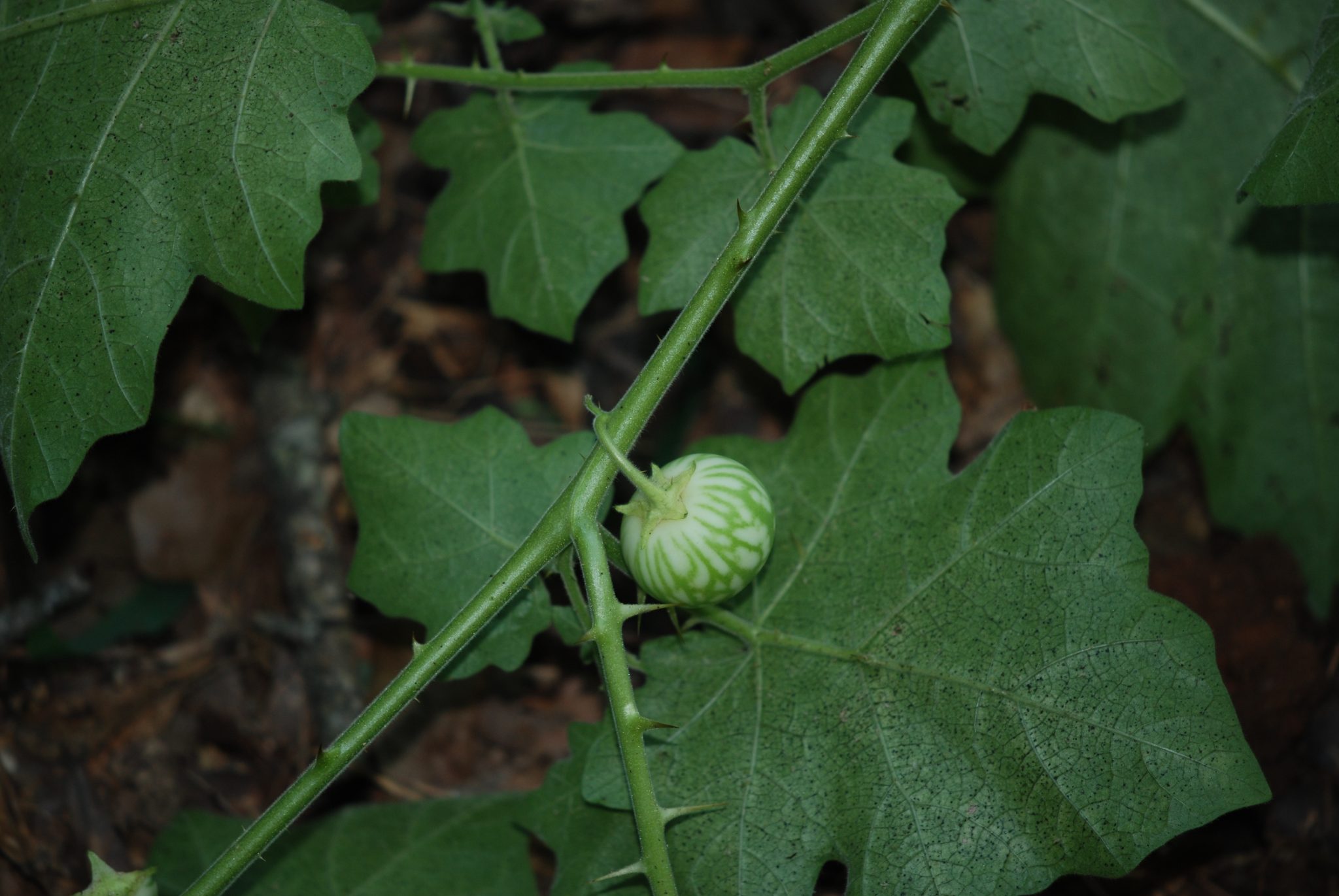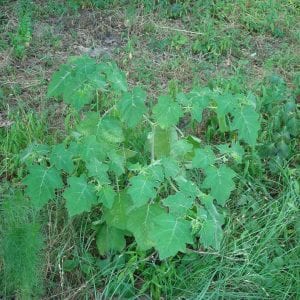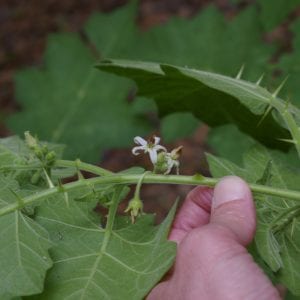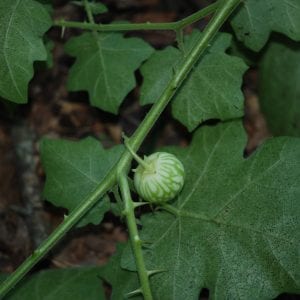Forestry & Wildlife

This invasive plant can greatly reduce forage productivity. Learn important measures you can take to prevent its spread.
Tropical soda apple (Solanum viarum), also referred to as TSA, is a non-native, invasive weed that forms very dense infestations, especially in pastures. Forage productivity can be greatly reduced as a result. It is also a host of several diseases and pests of commercial crops.
Listed by the USDA as a federal noxious weed, TSA was nearly eliminated across the state a decade ago through a federally funded eradication program. With termination of program funding, however, reports of TSA infestation are on the rise. For producers, timely identification and control of this invader will help to prevent its spread and protect your forage.
How do I identify tropical soda apple?
There are several species in the nightshade genus (Solanum) that might be confused with TSA. The most common look-alike is Carolina horsenettle (S. carolinense). TSA looks a bit like Carolina horsenettle on steroids—the plants, leaves, thorns, and fruit are all bigger.
Following are key features to help you identify tropical soda apple:
- Form: shallow-rooted, spreading, and thorny perennial shrub from 3 to 6 feet tall (figure 1).
- Leaves: 4 to 6 inches long and 2 to 6 inches wide, shallowly lobed with dense, sticky pubescence (velvety hair) on both sides, large prickles (½ to 1 inch) occur along the midveins on the upper and lower surfaces of leaves and along the stem. Carolina horsenettle leaves tend to be more narrow and the prickles are much smaller and only on veins on the bottom surface of the leaves.
- Flowers: May to August. Clusters of flowers with five white petals that are flat when first opened then curve back towards the stem; center is yellowish (figure 2). The petals of Carolina horsenettle are fused and range from white to lavender.
- Fruit: June to November. Round (1 to 1½ inches), smooth, mottled white and green (like watermelon rind) when immature (figure 3), turning yellow when ripe. Occur in the leaf axils. Calyx (green leafy material at the top of the fruit where it attaches to the stem) covers very little of the fruit. Carolina horsenettle fruit is smaller (~0.5 inches) and the calyx reaches nearly a third of the way down the side of the fruit.
- Figure 1. Tropical soda apple plant.
- Figure 2. Tropical soda apple flowers have five separate white petals that curl back with age. The leaves and stems have large prickles.
- Figure 3. Tropical soda apple fruit is green and white when young, becoming yellow when ripe. Each fruit contains hundreds of seeds.
Where does it grow?

Figure 4. Reported distribution of TSA. EDDMapS. 2019.
Early Detection and Distribution Mapping System. The University of Georgia, Center for Invasive Species and Ecosystem Health. Available online at www. eddmaps.org/; last accessed July 2, 2019.
TSA is most commonly found in pastures but is also found along fence rows and in ditches, open woods, and other semi-shady areas. It has been reported in scattered locations across the state and the Southeast (figure 4).
How is tropical soda apple spread?
Each TSA fruit contains several hundred seeds. The fruit is quite attractive to cattle and wildlife, which are the primary means of dispersal. Seed is also spread in contaminated hay, sod, manure, and on machinery. Note: While cattle and wildlife can eat the fruit, it is poisonous to humans.
How can I control tropical soda apple?
TSA is very shallow-rooted, and small shrubs can be pulled with a sturdy pair of gloves. (Make sure the gloves can withstand the thorns!) When hand pulling, remove as much of the root system as possible, as the roots may resprout. Cutting and mowing can be used to prevent seed formation, but it will not control the plants and should be avoided after the plants have set fruit. It is recommended that mature plants with fruit be cut, piled, and burned to kill the seed.
What herbicides can I use to spray tropical soda apple?
The best herbicide options for TSA in pastures are picloram + fluroxypyr, picloram + 2,4-D, aminopyralid + 2,4-D, or hexazinone. In forests, the best options are aminopyralid, triclopyr, and glyphosate. All of these herbicides benefit from the addition of a nonionic surfactant at 0.25 percent v/v. Aminopyralid, picloram, and hexazinone have longer soil residual than do fluroxypyr and triclopyr.
If spraying after mowing, allow 50 to 60 days of regrowth prior to spraying. Always read and follow the herbicide label. One treatment will not eradicate TSA, and follow-up monitoring and retreatment are critical. Treatments can be applied anytime during the late spring through early fall.
Table 1. Recommended Herbicide Rates and Uses
*See label for specific forest information.
| Herbicide Trade Name | Herbicide Active Ingredient(s) | Product Rate | Restricted Use | Recommended Use |
|---|---|---|---|---|
| Surmount | Picloram + fluroxypyr | 2 pt/A | Yes | Pastures |
| Grazon P+D | Picloram + 2,4-D | 2 pt/S | Yes | Pastures |
| GrazonNext HL | Aminopyralid + 2,4-D | 1.5 pt/A | No | Pastures |
| Velpar L | Hexazinone | 2 qt/A | No | Pastures, Forests* |
| Milestone VM | Aminopyralid | 7 fl oz/A or 0.5% v/v | No | Pastures, Forests*, ROWs |
| Remedy, Garlon 4 | Triclopyr ester | 1 qt/A or 2% v/v | No | Pastures, Forests, ROWs |
| Roundup, Accord Concentrate, Cornerstone, etc.’ | Glyphosate | 3% v/v | No | Forests, ROWs |
 Revised by Nancy J. Loewenstein, Extension Specialist, Forestry and Wildlife Sciences, and David Russell, Extension Specialist, Weed Science, both with Auburn University. Written by Nancy J. Loewenstein and Stephen F. Enloe, former Extension Specialist.
Revised by Nancy J. Loewenstein, Extension Specialist, Forestry and Wildlife Sciences, and David Russell, Extension Specialist, Weed Science, both with Auburn University. Written by Nancy J. Loewenstein and Stephen F. Enloe, former Extension Specialist.
Reviewed November 2023, Soda Apple Identification and Control, ANR-2596




